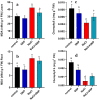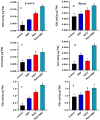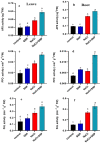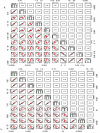Sodium nitroprusside application improves morphological and physiological attributes of soybean (Glycine max L.) under salinity stress
- PMID: 33861749
- PMCID: PMC8051766
- DOI: 10.1371/journal.pone.0248207
Sodium nitroprusside application improves morphological and physiological attributes of soybean (Glycine max L.) under salinity stress
Retraction in
-
Retraction: Sodium nitroprusside application improves morphological and physiological attributes of soybean (Glycine max L.) under salinity stress.PLoS One. 2022 Aug 3;17(8):e0272180. doi: 10.1371/journal.pone.0272180. eCollection 2022. PLoS One. 2022. PMID: 35921284 Free PMC article. No abstract available.
Abstract
Salinity is among the major abiotic stresses negatively affecting the growth and productivity of crop plants. Sodium nitroprusside (SNP) -an external nitric oxide (NO) donor- has been found effective to impart salinity tolerance to plants. Soybean (Glycine max L.) is widely cultivated around the world; however, salinity stress hampers its growth and productivity. Therefore, the current study evaluated the role of SNP in improving morphological, physiological and biochemical attributes of soybean under salinity stress. Data relating to biomass, chlorophyll and malondialdehyde (MDA) contents, activities of various antioxidant enzymes, ion content and ultrastructural analysis were collected. The SNP application ameliorated the negative effects of salinity stress to significant extent by regulating antioxidant mechanism. Root and shoot length, fresh and dry weight, chlorophyll contents, activities of various antioxidant enzymes, i.e., catalase (CAT), superoxide dismutase (SOD), peroxidase (POD) and ascorbate peroxidase (APX) were improved with SNP application under salinity stress compared to control treatment. Similarly, plants treated with SNP observed less damage to cell organelles of roots and leaves under salinity stress. The results revealed pivotal functions of SNP in salinity tolerance of soybean, including cell wall repair, sequestration of sodium ion in the vacuole and maintenance of normal chloroplasts with no swelling of thylakoids. Minor distortions of cell membrane and large number of starch grains indicates an increase in the photosynthetic activity. Therefore, SNP can be used as a regulator to improve the salinity tolerance of soybean in salt affected soils.
Conflict of interest statement
The authors have declared that no competing interests exist.
Figures





Similar articles
-
Bacillus firmus (SW5) augments salt tolerance in soybean (Glycine max L.) by modulating root system architecture, antioxidant defense systems and stress-responsive genes expression.Plant Physiol Biochem. 2018 Nov;132:375-384. doi: 10.1016/j.plaphy.2018.09.026. Epub 2018 Sep 21. Plant Physiol Biochem. 2018. PMID: 30268029
-
Exogenous Sodium Nitroprusside Mitigates Salt Stress in Lentil (Lens culinaris Medik.) by Affecting the Growth, Yield, and Biochemical Properties.Molecules. 2021 Apr 28;26(9):2576. doi: 10.3390/molecules26092576. Molecules. 2021. PMID: 33925107 Free PMC article.
-
Morphological and physiological responses of cotton (Gossypium hirsutum L.) plants to salinity.PLoS One. 2014 Nov 12;9(11):e112807. doi: 10.1371/journal.pone.0112807. eCollection 2014. PLoS One. 2014. PMID: 25391141 Free PMC article.
-
Zinc oxide nanoparticles influence on plant tolerance to salinity stress: insights into physiological, biochemical, and molecular responses.Environ Geochem Health. 2024 Apr 5;46(5):148. doi: 10.1007/s10653-024-01921-8. Environ Geochem Health. 2024. PMID: 38578547 Review.
-
Antioxidant defense in cotton under environmental stresses: Unraveling the crucial role of a universal defense regulator for enhanced cotton sustainability.Plant Physiol Biochem. 2023 Nov;204:108141. doi: 10.1016/j.plaphy.2023.108141. Epub 2023 Oct 25. Plant Physiol Biochem. 2023. PMID: 37926000 Review.
Cited by
-
Selenium seed priming enhanced the growth of salt-stressed Brassica rapa L. through improving plant nutrition and the antioxidant system.Front Plant Sci. 2023 Jan 13;13:1050359. doi: 10.3389/fpls.2022.1050359. eCollection 2022. Front Plant Sci. 2023. PMID: 36714767 Free PMC article.
-
Transcriptomic and physiological analysis of the response of Spirodela polyrrhiza to sodium nitroprusside.BMC Plant Biol. 2024 Feb 8;24(1):95. doi: 10.1186/s12870-024-04766-6. BMC Plant Biol. 2024. PMID: 38331719 Free PMC article.
-
Nano-Zinc Oxide Can Enhance the Tolerance of Apple Rootstock M9-T337 Seedlings to Saline Alkali Stress by Initiating a Variety of Physiological and Biochemical Pathways.Plants (Basel). 2025 Jan 15;14(2):233. doi: 10.3390/plants14020233. Plants (Basel). 2025. PMID: 39861585 Free PMC article.
-
Growth regulators promote soybean productivity: a review.PeerJ. 2022 Mar 4;10:e12556. doi: 10.7717/peerj.12556. eCollection 2022. PeerJ. 2022. PMID: 35265396 Free PMC article. Review.
-
Exogenous nitric oxide promotes salinity tolerance in plants: A meta-analysis.Front Plant Sci. 2022 Nov 7;13:957735. doi: 10.3389/fpls.2022.957735. eCollection 2022. Front Plant Sci. 2022. PMID: 36420041 Free PMC article.
References
-
- Zhang XK, Zhou QH, Cao JH, & Yu BJ. Differential Cl−/Salt Tolerance and NaCl induced alternations of tissue and cellular ion fluxes in Glycine max, Glycine soja and their hybrid seedlings. J Agron Crop Sci. 2011; 197: 329–339.
Publication types
MeSH terms
Substances
LinkOut - more resources
Full Text Sources
Other Literature Sources
Miscellaneous

